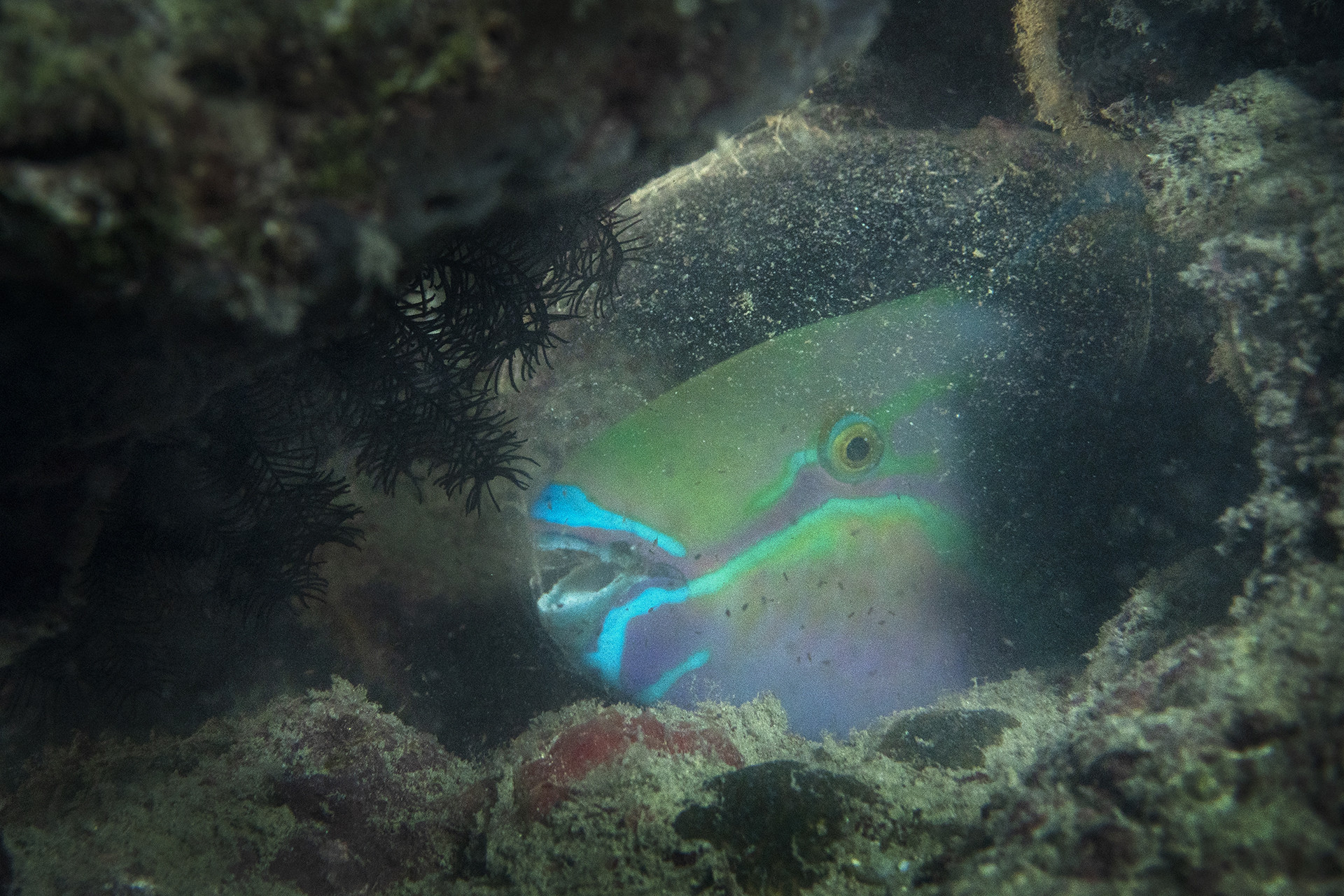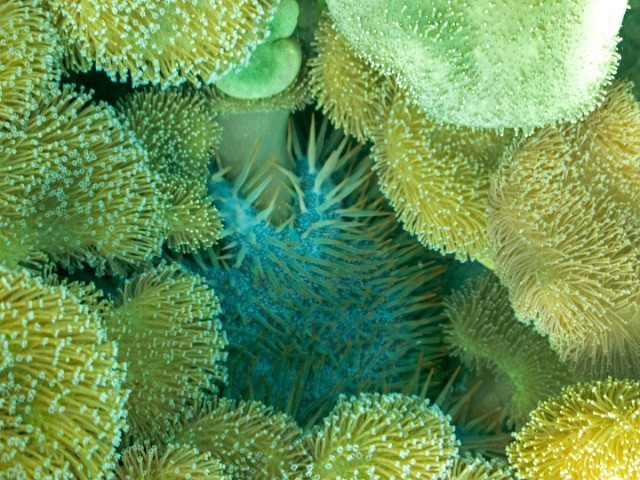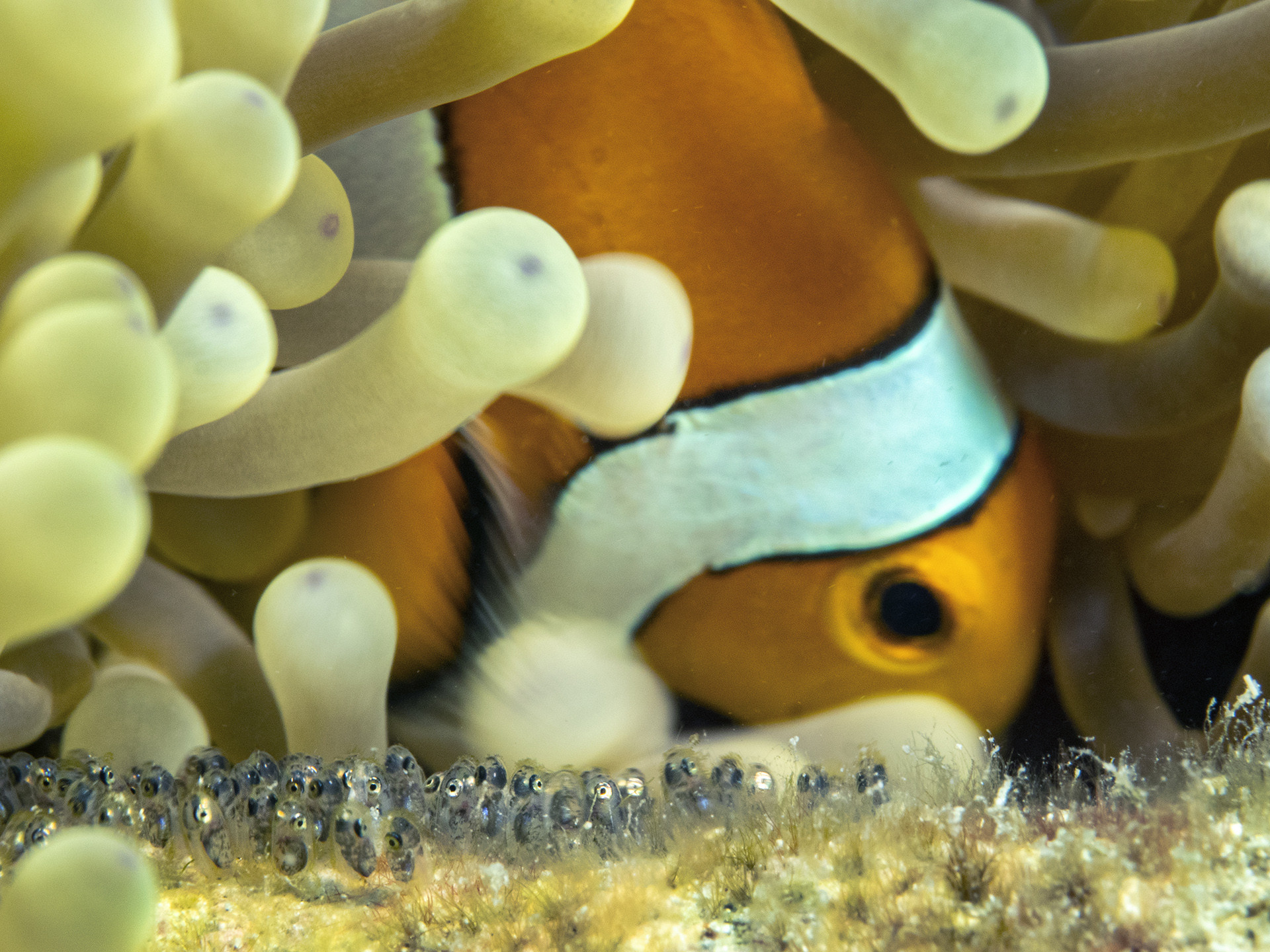When it comes to fighting infections in humans, mucus is the real MVP. But in the ocean, it is so much more! Some marine animals use it to move or even capture prey, while others use it for protection and defence. For some species, in the absence of cues involving sight, sound and smell, mucus layers become the primary feature for communication and inter-species recognition. Today, mucus samples are even used as an alternative and non-invasive method for collecting the DNA of threatened and endangered marine species.
Just like your garden snail, marine snails use mucus to move. Their slimy trails can be observed on rocks exposed at low tide. Their planktonic counterparts (snails that live in the water column drifting at the mercy of the winds and currents), make large mesh nets to capture small particulate matter and planktonic prey like phytoplankton and crunchy copepods.
A majority of the planktonic life that filter feeds its way to survival use mucus and these include, but are not limited to, sea salps, pteropods, gastropods and appendicularians. Appendicularians (or Larvaceans), for example, close relatives to us chordates, build elaborate mucus homes to pump water through and capture their prey. Although I have never seen one, textbook drawings show them to be structurally very advanced, looking like hi-tech spaceships with the animal in the centre producing circulatory currents with the force of its tail. These super advanced (almost alien-like) creatures are also able to selectively choose desired prey by modifying mucus mesh size and design!
Plankton forms the basis of the marine food web and these mucus-producing filter feeders not only support entire food chains that lead up to the largest of marine life, but their mucus waste also plays an important role in carbon cycling. Waste mucus often creates aggregates with other organic matter, producing clumpy masses that eventually sink to the sea floor, aiding in carbon sequestration. If you are a diver you might have already come across this ‘marine snow’ and/or ‘sea snot’, that drives visibility down but is vital in carbon and nutrient cycling.
The earth's most diverse ecosystems - our gorgeous coral reefs - also depend on this life-saving slime. Scleractinians or reef-building hard corals, the ecosystem engineers that support 25% of global marine diversity, produce mucus to capture food and prevent sedimentation, biofouling, desiccation and UV radiation. In the Andamans, and other areas of high sediment runoff, you will find live coral growing amidst piles of silty mud and it is the mucus that keeps the sediment off the animal tissue enabling it to live, breathe and photosynthesise.
Similar to reef coral, fish mucus is a storehouse of antimicrobial, immune-related, metabolic and UV protection compounds but their coolest use, by far, is demonstrated by sleeping parrotfish. Certain species of parrotfish produce a mucus envelope at night that covers them from mouth to tail, protecting them from predators like moray eels, parasites like isopods and gastropods, and bacteria and silt deposition. The mucus enables these super-active daytime herbivores to get a peaceful night's rest and acts like an early warning system to unwarranted contact.
Protection and defence are the two sides of the same slimy coin. The mutualism between clownfish and its host anemone is by far the most well-recognised of ocean symbiotic relationships, but few know it is the fish’s mucus coating that keeps the anemone from firing its lethal nematocysts.
Anemones are close relatives of jellyfish and belong to the phylum Cnidaria. These sessile animals possess millions of stinging cells (nematocysts) and venoms with haemolytic, neurotoxic and cardiotoxic properties that are used in defence and to capture prey. The clownfish-anemone relationship evolved at least 10 million years ago, providing mutual benefits to both species including protection from predators and parasites, increased nourishment and reproductive benefits.
Clownfish develop a protective mucus coating with certain microbial and chemical signatures that enable the anemone host to recognise them as their own and prevent the triggering of nematocysts and the discharge of toxins. Clownfish eggs are laid and fertilised in close proximity to the anemone, and chemical signatures from the anemone imprint onto the developing larvae. After hatching the larvae lead a life planktonic, drifting with the currents for 7-10 days before metamorphosing into the adult phase, settling down (usually within 100 meters of its parents) into the same anemone species with its imprinted mucus coat without as much as a sting or tickle.
It is clear we need to thank our mucus membranes and those of the countless marine creatures that are making life more productive and secure albeit a little sticky. Unfortunately, excess mucus production can be an indicator of declining health. In the oceans, sudden explosions of sea snot have been linked to oil spills, temperature rise and disease spread. Mucus has the power to protect, preserve and destroy, so in this narcissistic age, it is a good thing science does not shy away from slime!
References:
ELASMOBRANCH RESEARCH REFERENCES:
Kashiwagi, T., Maxwell, E.A., Marshall, A.D. and Christensen, A.B. 2015. Evaluating mantra ray mucus as an alternative DNA source for population genetics study: underwater-sampling, dry-storage and PCR success. PeerJ, 1188:1-13
Lieber, L., Berrow, S., Johnston, E., Hall, G. Et al. 2013. Mucus: aiding elasmobranch conservation through non-invasive genetic sampling. Endangered Species Research, 21:215–222
https://www.forbes.com/sites/melissacristinamarquez/2019/05/06/sex-and-mucus-uncovering-rays-secrets/#25df994b4983
PLANKTON REFERENCES:
Conley, K.R., Gemmell, B.J., Bouquet, J.‐M., Thompson, E.M. and Sutherland, K.R. 2018. A self‐cleaning biological filter: How appendicularians mechanically control particle adhesion and removal. Limnol. Oceanogr., 63: 927-938
R. E. Sherlock, K. R. Walz, and B. H. Robison (2016). The first definitive record of the giant larvacean, Bathochordaeus charon, since its original description in 1900 and a range extension to the northeast Pacific Ocean. Marine Biodiversity Records, DOI:10.1186/s41200-016-0075-9
CORAL REFERENCES:
Huettel, M., Wild, C. And Gonelli, S. 2006. Mucus traps in coral reefs: formation and temporal evolution of particle aggregates caused by coral mucus. Marine Ecology Progress Series, 307: 69-84.
Ritchie, K.B. 2006. Regulation of microbial populations by coral surface mucus and mucus-associated bacteria. Marine Ecology Progress Series, 322: 1-14.
GENERAL FISH REFERENCES:
Reverter, M., Tapissier-Bontemps, N., Lecchini, D., et al. 2018. Biological and ecological roles of external fish mucus: A review. Fishes, 3(41): 1-19
PARROTFISH REFERENCES:
Bouchet, P. And Perrine, D. 1996. More gastropods feeding at night on parrotfishes. Bulletin of Marine Science, 59(1): 224-228
Byrne, J.E. 1970. Mucus envelope formation in two species of Hawaiian parrotfishes (Genus Scarus). Pacific Science, 24: 490-493
Grutter, A.S., Rumney, J.G., Sinclair-Taylor, T., Waldie, P. And Franklin, C.E. 2011. Fish mucus cocoons: the ‘mosquito nets’ of the sea. Biological Letters, 7: 292-294
Winn, H.E. 1955 Formation of a mucus envelope at night by parrotfishes. Zoologica, 40: 145-148
Winn, H.E. and Bardach, J.E. 1959. Differential food selection by moray eels and a possible role of the mucus envelope of parrotfishes in reduction of predation. Ecology, 40(2): 296-298
CLOWNFISH - ANEMONE REFERENCES:
Arvedlund, M., McCormick, M.I., Fautin, D.G., and Bildsoe, M. 1999. Host recognition and possible imprinting in the anemone fish Amphiprion melanomas (Pisces: Pomacentridae). Marine Ecology Progress Series, 188: 207-218
Burke da Silva, K., and Nedosyko, A. Sea anemones and anemonefish: a match made in heaven. Chapter 27 in S. Goffredo, Z. Dubinsky (eds.), The Cnidaria, Past, Present and Future. Pg 425-438
Jones, G.P., Planes, S., and Thorrold, S.R. 2005. Coral Reef Fish Larvae Settle Close to Home. Current Biology, 15 (14): 1314-1318
Pratte, Z.A., Patin, N.V., McWhirt, M.E. et al. 2018. Association with a sea anemone alters the skin microbiome of clownfish. Coral Reefs, 37: 1119-1125









